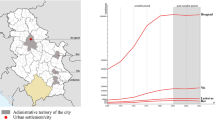Abstract
A case study of growth in retail trade and services in districts with socialist-time large housing estates in Leningrad–St. Petersburg during the period of 1989–2016 has revealed and validates the three principles of development of spatiotemporal systems (STS) in the process of transformation: change in the essence of transformation of an urban STS; continuity of spatial, temporal, and essential parameters of transformation of an urban STS; and the principle of possible misalignment of hierarchies of the spatial, temporal, and essential parameters of transformational urban STSs. Six stages of development of retail trade during the studied period are described: early transformation, the first stage of administrative reform, the stage of pavilions and markets, the stage of displacement of specific transformational forms, the stage of predominance of stationary trade forms, and the stage of corner stores. The corresponding spatial forms and particular features of the organization of retail STS are characterized by: the agglomeration of kiosks and vendors near metro stations and public transport stops; the agglomeration of kiosks and pavilions near metro stations plus markets; tents and mobile forms of trade near metro stations plus new markets; trade malls, stationary markets plus kiosk trade chains; hypermarkets, trade chains, temporary agglomerations near public transport stops and metro stations; neighborhood stores and illegal kiosks. A methodology for studying complex STSs is developed, and its effectiveness is fine-tuned and tested.


Similar content being viewed by others
Notes
Depending on the aims of particular studies, different criteria for defining this territory may be used.
As a result of a special test carried out in the aforementioned study, it was determined that such method recorded more than 80% of real retail trade objects.
Similar phases are described by researchers for other large cities as well [4].
The term was suggested by E. А. Bondarchuk.
REFERENCES
Aksenov, K., Brade, I., and Bondarchuk, E., Transformatsionnoe i posttransformatsionnoe gorodskoe prostranstvo. Leningrad–Sankt-Peterburg 1989–2002 (Transformational and Posttransformational Urban Space: Leningrad–St. Petersburg, 1989–2002), St. Petersburg: Gelikon-Plyus, 2006.
Aksenov, K.E., Systemic properties of space–time in the transformation of the sociogeographical space, Izv. Ross. Geogr. O-va, 2014, vol. 146, no. 4, pp. 69–80.
Aksenov, K.E., The evolution of shopping types and the spatial organization of retail trade in the post-Soviet metropolis, Izv. Ross. Geogr. O-va, 2016, vol. 148, no. 6, pp. 39–56.
Grigor’eva, M.A., Retail trade in a large Siberian city: current state and development trends, Naukovedenie, 2017, vol. 9, no. 6. https://naukovedenie.ru/PDF/41EVN617.pdf.
Imangalin, A.F., Location and territorial accessibility of market services in large cities, Extended Abstract of Cand. Sci. (Geogr.) Dissertation, Moscow, 2015.
Isachenko, A.G., Teoriya i metodologiya geograficheskoi nauki (Theory and Practice of Geographical Science), Moscow: Akademiya, 2004.
Isachenko, G.A., Interpretation of changes in the cultural landscape in terms of dynamic landscape science, Izv. Ross. Akad. Nauk, Ser. Geogr., 2017, vol. 149, no. 1, pp. 20–34.
Kayasov, A.A., Prospective development of business centers in Russian regions, Vestn. Samar. Gos. Arkh.-Stroit. Univ., Gradostroit. Arkh., 2011, no. 4, pp. 16–20.
Kayasov, A.A., Principles of formation and characteristics of business areas in Russian cities, in Traditsii i innovatsii v stroitel’stve i arkhitekture. Gradostroitel’stvo (Traditions and Innovations in Building Construction and Architecture: Urban Planning), Samara: Samar. Gos. Arkh.-Stroit. Univ., 2015, pp. 73–77.
Lastochkin, A.N., Obshchaya teoriya geosistem (General Theory of Geosystems), St. Petersburg: Lema, 2011.
Turovskii, R.F., Kul’turnye landshafty Rossii (Cultural Landscapes of Russia), Moscow: Ross. Nauchno-Issled. Inst. Kul’t. Prirod. Naslediya, 1998.
Axenov, K., Krupickaitė, D., Morachevskaya, K., and Zinovyev, A., Retail sprawl in post-Soviet urban residential communities: case studies of Saint-Petersburg and Vilnius, Moravian Geogr. Rep., 2018, vol. 26, no. 3, pp. 210–219.
Urban Sprawl in Europe: Landscape, Land-Use Change and Policy, Couch, C., Leontidou, L., and Petschel-Held, G., Eds., New York: Wiley, 2007.
Garb, Y. and Dybicz, T., The retail revolution in post-socialist Central Europe and its lessons, in The Urban Mosaic of Post-Socialist Europe, Tsenkova, S. and Nedović-Budić, Z., Eds., New York: Physica-Verlag, 2006, pp. 231–252.
Karamychev, V. and van Reeven, P., Retail sprawl and multi-store firms: An analysis of location choice by retail chains, Reg. Sci. Urban Econ., 2009, vol. 39, no. 3, pp. 277–286.
Nagy, E., Winners and losers in the transformation of city centre retailing in East Central Europe, Eur. Urban Reg. Stud., 2001, vol. 8, no. 4, pp. 340–348.
Peri-Urban Futures: Scenarios and Models for Land Use Change in Europe, Nilsson, K., Pauleit, S., Bell, S., , Eds., Berlin: Springer-Verlag, 2013.
Pojani, D., Urban and suburban retail development in Albania’s capital after socialism, Land Use Policy, 2011, vol. 28, no. 4, pp. 836–845.
Simion, G. and Nistor, C., Spatial structure changes inside post-communist capital city of Bucharest, Hum. Geogr., 2012, vol. 6, no. 1, pp. 79–89.
Stanilov, K., The restructuring of non-residential uses in the post-socialist metropolis, in The Post-Socialist City: Urban Form and Space Transformations in Central and Eastern Europe after Socialism, Stanilov, K., Ed., New York: Springer-Verlag, 2007, pp. 73–99.
Sýkora, L. and Bouzarovski, S., Multiple transformations: conceptualizing the post-communist urban transition, Urban Stud., 2012, vol. 49, pp. 43–60.
Sýkora, L. and Ouředníček, M., Sprawling post-communist metropolis: commercial and residential suburbanization in Prague and Brno, the Czech Republic, in Employment Deconcentration in European Metropolitan Areas: Market Forces Versus Planning Regulations, Razin, E., Dijst, M., and Vázquez, C., Eds., Dordrecht: Springer-Verlag, 2007, pp. 209–233.
Rudolph, R., Stadtzentren russischer Grosstadte in der Transformation—St. Petersburg und Jekaterinburg, in Beitrage zur Regionalen Geographie, 54, Leipzig: Leibniz-Inst. Länderkunde, 2001.
Funding
This paper was supported by the Russian Academic Excellence Project at the Immanuel Kant Baltic Federal University.
Author information
Authors and Affiliations
Corresponding author
Ethics declarations
The author declares that he has no conflicts of interest.
Additional information
Translated by A. Dunaeva
Rights and permissions
About this article
Cite this article
Aksenov, K.E. Transformation of Urban Spatiotemporal Systems: the Influence of Retail on the Post-Socialist Large Housing Estates Areas in Leningrad–St. Petersburg in 1989–2016. Reg. Res. Russ. 9, 225–235 (2019). https://doi.org/10.1134/S2079970519030018
Received:
Revised:
Accepted:
Published:
Issue Date:
DOI: https://doi.org/10.1134/S2079970519030018




